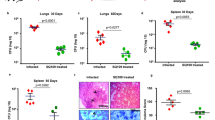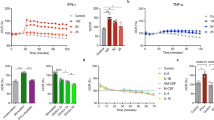Abstract
Mycobacterium tuberculosis infection leads to cytosolic release of the bacterial cyclic dinucleotide (CDN) c-di-AMP and a host-generated CDN, cGAMP, both of which trigger type I interferon (IFN) expression in a STING-dependent manner. Here we report that M. tuberculosis has developed a mechanism to inhibit STING activation and the type I IFN response via the bacterial phosphodiesterase (PDE) CdnP, which mediates hydrolysis of both bacterial-derived c-di-AMP and host-derived cGAMP. Mutation of cdnP attenuates M. tuberculosis virulence, as does loss of a host CDN PDE known as ENPP1. CdnP is inhibited by both US Food and Drug Administration (FDA)-approved PDE inhibitors and nonhydrolyzable dinucleotide mimetics specifically designed to target the enzyme. These findings reveal a crucial role of CDN homeostasis in governing the outcome of M. tuberculosis infection as well as a unique mechanism of subversion of the host's cytosolic surveillance pathway (CSP) by a bacterial PDE that may serve as an attractive antimicrobial target.
This is a preview of subscription content, access via your institution
Access options
Subscribe to this journal
Receive 12 print issues and online access
$259.00 per year
only $21.58 per issue
Buy this article
- Purchase on Springer Link
- Instant access to full article PDF
Prices may be subject to local taxes which are calculated during checkout






Similar content being viewed by others
References
Kalia, D. et al. Nucleotide, c-di-GMP, c-di-AMP, cGMP, cAMP, (p)ppGpp signaling in bacteria and implications in pathogenesis. Chem. Soc. Rev. 42, 305–341 (2013).
Römling, U. Great times for small molecules: c-di-AMP, a second messenger candidate in Bacteria and Archaea. Sci. Signal. 1, pe39 (2008).
Corrigan, R.M. & Gründling, A. Cyclic di-AMP: another second messenger enters the fray. Nat. Rev. Microbiol. 11, 513–524 (2013).
Bowie, A.G. Innate sensing of bacterial cyclic dinucleotides: more than just STING. Nat. Immunol. 13, 1137–1139 (2012).
Parvatiyar, K. et al. The helicase DDX41 recognizes the bacterial secondary messengers cyclic di-GMP and cyclic di-AMP to activate a type I interferon immune response. Nat. Immunol. 13, 1155–1161 (2012).
Woodward, J.J., Iavarone, A.T. & Portnoy, D.A. c-di-AMP secreted by intracellular Listeria monocytogenes activates a host type I interferon response. Science 328, 1703–1705 (2010).
Dey, B. & Bishai, W.R. Crosstalk between Mycobacterium tuberculosis and the host cell. Semin. Immunol. 26, 486–496 (2014).
Burdette, D.L. et al. STING is a direct innate immune sensor of cyclic di-GMP. Nature 478, 515–518 (2011).
Fitzgerald, K.A. et al. IKKɛ and TBK1 are essential components of the IRF3 signaling pathway. Nat. Immunol. 4, 491–496 (2003).
Dey, B. et al. A bacterial cyclic dinucleotide activates the cytosolic surveillance pathway and mediates innate resistance to tuberculosis. Nat. Med. 21, 401–406 (2015).
Diner, E.J. et al. The innate immune DNA sensor cGAS produces a noncanonical cyclic dinucleotide that activates human STING. Cell Rep. 3, 1355–1361 (2013).
Collins, A.C. et al. Cyclic GMP-AMP synthase is an innate immune DNA sensor for Mycobacterium tuberculosis. Cell Host Microbe 17, 820–828 (2015).
Gao, D. et al. Cyclic GMP-AMP synthase is an innate immune sensor of HIV and other retroviruses. Science 341, 903–906 (2013).
Zhang, Y. et al. The DNA sensor, cyclic GMP-AMP synthase, is essential for induction of IFN-β during Chlamydia trachomatis infection. J. Immunol. 193, 2394–2404 (2014).
Wassermann, R. et al. Mycobacterium tuberculosis differentially activates cGAS- and inflammasome-dependent intracellular immune responses through ESX-1. Cell Host Microbe 17, 799–810 (2015).
Li, X.D. et al. Pivotal roles of cGAS-cGAMP signaling in antiviral defense and immune adjuvant effects. Science 341, 1390–1394 (2013).
Sun, L., Wu, J., Du, F., Chen, X. & Chen, Z.J. Cyclic GMP-AMP synthase is a cytosolic DNA sensor that activates the type I interferon pathway. Science 339, 786–791 (2013).
Wu, J. et al. Cyclic GMP-AMP is an endogenous second messenger in innate immune signaling by cytosolic DNA. Science 339, 826–830 (2013).
Hansen, K. et al. Listeria monocytogenes induces IFNβ expression through an IFI16-, cGAS- and STING-dependent pathway. EMBO J. 33, 1654–1666 (2014).
Lahaye, X. et al. The capsids of HIV-1 and HIV-2 determine immune detection of the viral cDNA by the innate sensor cGAS in dendritic cells. Immunity 39, 1132–1142 (2013).
Orzalli, M.H., DeLuca, N.A. & Knipe, D.M. Nuclear IFI16 induction of IRF-3 signaling during herpesviral infection and degradation of IFI16 by the viral ICP0 protein. Proc. Natl. Acad. Sci. USA 109, E3008–E3017 (2012).
Li, T., Chen, J. & Cristea, I.M. Human cytomegalovirus tegument protein pUL83 inhibits IFI16-mediated DNA sensing for immune evasion. Cell Host Microbe 14, 591–599 (2013).
Wu, J.J. et al. Inhibition of cGAS DNA sensing by a herpesvirus virion protein. Cell Host Microbe 18, 333–344 (2015).
Lau, L., Gray, E.E., Brunette, R.L. & Stetson, D.B. DNA tumor virus oncogenes antagonize the cGAS-STING DNA-sensing pathway. Science 350, 568–571 (2015).
Yang, J. et al. Deletion of the cyclic di-AMP phosphodiesterase gene (cnpB) in Mycobacterium tuberculosis leads to reduced virulence in a mouse model of infection. Mol. Microbiol. 93, 65–79 (2014).
Manikandan, K. et al. Two-step synthesis and hydrolysis of cyclic di-AMP in Mycobacterium tuberculosis. PLoS One 9, e86096 (2014).
Postic, G., Danchin, A. & Mechold, U. Characterization of NrnA homologs from Mycobacterium tuberculosis and Mycoplasma pneumoniae. RNA 18, 155–165 (2012).
Bai, Y. et al. Two DHH subfamily 1 proteins in Streptococcus pneumoniae possess cyclic di-AMP phosphodiesterase activity and affect bacterial growth and virulence. J. Bacteriol. 195, 5123–5132 (2013).
Cho, K.H. & Kang, S.O. Streptococcus pyogenes c-di-AMP phosphodiesterase, GdpP, influences SpeB processing and virulence. PLoS One 8, e69425 (2013).
Du, B. et al. Functional analysis of c-di-AMP phosphodiesterase, GdpP, in Streptococcus suis serotype 2. Microbiol. Res. 169, 749–758 (2014).
Rao, F. et al. YybT is a signaling protein that contains a cyclic dinucleotide phosphodiesterase domain and a GGDEF domain with ATPase activity. J. Biol. Chem. 285, 473–482 (2010).
Srivastav, R. et al. Unique subunit packing in mycobacterial nanoRNase leads to alternate substrate recognitions in DHH phosphodiesterases. Nucleic Acids Res. 42, 7894–7910 (2014).
Lamichhane, G. et al. A postgenomic method for predicting essential genes at subsaturation levels of mutagenesis: application to Mycobacterium tuberculosis. Proc. Natl. Acad. Sci. USA 100, 7213–7218 (2003).
Corrigan, R.M., Abbott, J.C., Burhenne, H., Kaever, V. & Gründling, A. c-di-AMP is a new second messenger in Staphylococcus aureus with a role in controlling cell size and envelope stress. PLoS Pathog. 7, e1002217 (2011).
Wang, J. et al. Conservative change to the phosphate moiety of cyclic diguanylic monophosphate remarkably affects its polymorphism and ability to bind DGC, PDE, and PilZ proteins. J. Am. Chem. Soc. 133, 9320–9330 (2011).
Witte, C.E. et al. Cyclic di-AMP is critical for Listeria monocytogenes growth, cell wall homeostasis, and establishment of infection. MBio 4, e00282–13 (2013).
Watson, R.O. et al. The cytosolic sensor cGAS detects Mycobacterium tuberculosis DNA to induce type I interferons and activate autophagy. Cell Host Microbe 17, 811–819 (2015).
Li, L. et al. Hydrolysis of 2′3′-cGAMP by ENPP1 and design of nonhydrolyzable analogs. Nat. Chem. Biol. 10, 1043–1048 (2014).
Kubota, K. et al. Identification of 2′-phosphodiesterase, which plays a role in the 2-5A system regulated by interferon. J. Biol. Chem. 279, 37832–37841 (2004).
Rorbach, J., Nicholls, T.J. & Minczuk, M. PDE12 removes mitochondrial RNA poly(A) tails and controls translation in human mitochondria. Nucleic Acids Res. 39, 7750–7763 (2011).
Kim, M.J. et al. Caseation of human tuberculosis granulomas correlates with elevated host lipid metabolism. EMBO Mol. Med. 2, 258–274 (2010).
Rachman, H. et al. Unique transcriptome signature of Mycobacterium tuberculosis in pulmonary tuberculosis. Infect. Immun. 74, 1233–1242 (2006).
Konno, H., Konno, K. & Barber, G.N. Cyclic dinucleotides trigger ULK1 (ATG1) phosphorylation of STING to prevent sustained innate immune signaling. Cell 155, 688–698 (2013).
Liang, Q. et al. Crosstalk between the cGAS DNA sensor and Beclin-1 autophagy protein shapes innate antimicrobial immune responses. Cell Host Microbe 15, 228–238 (2014).
Målen, H., Pathak, S., Søfteland, T., de Souza, G.A. & Wiker, H.G. Definition of novel cell envelope associated proteins in Triton X-114 extracts of Mycobacterium tuberculosis H37Rv. BMC Microbiol. 10, 132 (2010).
Ablasser, A. et al. Cell intrinsic immunity spreads to bystander cells via the intercellular transfer of cGAMP. Nature 503, 530–534 (2013).
Andrade, W.A. et al. Group B Streptococcus degrades cyclic-di-AMP to modulate STING-dependent type I interferon production. Cell Host Microbe 20, 49–59 (2016).
Barker, J.R. et al. STING-dependent recognition of cyclic di-AMP mediates type I interferon responses during Chlamydia trachomatis infection. MBio 4, e00018–13 (2013).
Schoonmaker, M.K., Bishai, W.R. & Lamichhane, G. Nonclassical transpeptidases of Mycobacterium tuberculosis alter cell size, morphology, the cytosolic matrix, protein localization, virulence, and resistance to β-lactams. J. Bacteriol. 196, 1394–1402 (2014).
Acknowledgements
We gratefully acknowledge support from NIAID (grants AI037856, AI097138, and AI036973 to W.R.B.), the Howard Hughes Medical Institute (W.R.B.), and the NSF (grants CHE 1307218 and CHE 1636752 to H.O.S.). Funding from the Camille and Dreyfus Foundation (Teacher-Scholar fellowship to H.O.S.) is also acknowledged. Y.Z. is supported by a Mehta Research Award. J.Z. is supported by a University of Maryland Graduate Dean's Dissertation Fellowship. We thank B. Roembke at UMD for help with dinucleotide synthesis. We thank H.W. Virgin IV and D. MacDuff (Washington University School of Medicine, St. Louis, Missouri, USA) for generously providing bone marrow cells from cGAS-deficient mice. We thank A. Sher and K. Mayer-Barber (NIH, Bethesda, Maryland, USA) for generously providing Ifnar1−/− mice. We thank K.-P. Hopfner (Department of Biochemistry and Gene Center, Ludwig-Maximilians-University, Munich, Germany) for providing the plasmid to make DisA. We thank A. Gründling (Section of Microbiology and MRC Centre for Molecular Bacteriology and Infection, Imperial College London, London, UK) for providing the plasmid to make GdpP. We thank Z.-X. Liang (Division of Structural Biology and Biochemistry, School of Biological Sciences, Nanyang Technological University, Singapore) for providing the plasmid to make YybT. We thank S. Pelly for editing the manuscript.
Author information
Authors and Affiliations
Contributions
R.J.D., B.D., and Y.Z. designed the experiments in consultation with W.R.B. and H.O.S. Molecular biology, microbiology, cell culture, and animal-based experiments were performed by R.J.D. and B.D. Y.Z. performed biochemical enzymatic assays. J.Z. and D.S. performed chemical synthesis of compounds. L.S.C. contributed to mass spectrometry experiments. P.K. and G.L. contributed to isothermal titration calorimetry experiments. H.G. contributed to mouse experiments. R.J.D. and B.D. wrote the manuscript with input from Y.Z., J.Z., D.S., P.K., L.S.C., H.O.S., and W.R.B. W.R.B. provided overall supervision of the study. All the authors contributed to editing of the manuscript and approved the conclusions.
Corresponding authors
Ethics declarations
Competing interests
The authors declare no competing financial interests.
Supplementary information
Supplementary Text and Figures
Supplementary Results, Supplementary Tables 1–4 and Supplementary Figures 1–19. (PDF 1856 kb)
Supplementary Note
Synthetic Procedures. (PDF 1427 kb)
Rights and permissions
About this article
Cite this article
Dey, R., Dey, B., Zheng, Y. et al. Inhibition of innate immune cytosolic surveillance by an M. tuberculosis phosphodiesterase. Nat Chem Biol 13, 210–217 (2017). https://doi.org/10.1038/nchembio.2254
Received:
Accepted:
Published:
Issue Date:
DOI: https://doi.org/10.1038/nchembio.2254
This article is cited by
-
P26 enhances baculovirus gene delivery by modulating the mammalian antiviral response
Applied Microbiology and Biotechnology (2023)
-
The interactions between cGAS-STING pathway and pathogens
Signal Transduction and Targeted Therapy (2020)
-
Ring nucleases deactivate type III CRISPR ribonucleases by degrading cyclic oligoadenylate
Nature (2018)
-
Regulating STING in health and disease
Journal of Inflammation (2017)
-
Nucleotide circles of life and death
Nature Chemical Biology (2017)



